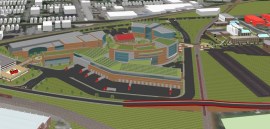
by Brianna Crandall — September 22, 2014—The University of Louisville has just unveiled “bold new images” that depict how its pace-setting Belknap Engineering and Applied Sciences Research Park might look when completed—although school officials stress that no final decisions have been made concerning the look or format of the innovative park.
The conceptual renderings, created by Louisville firms Stengel Hill Architecture and Qk4, show a vibrant research complex adjacent to the J.B. Speed School of Engineering on UofL’s Belknap Campus.
The park, which is being developed by the University of Louisville Foundation, will include research facilities for the engineering school, offices for applied sciences researchers, and space for private companies that want to form partnerships with the university. It will be anchored by the Institute for Product Realization, consisting of a co-creation hub, research and education space, micro-factory and “launch pad” for emerging private companies.
The park “will position emerging businesses and products alongside faculty, students and researchers at UofL,” said Kentucky Governor Steve Beshear. “That collaboration will help develop the innovations that will support Kentucky businesses and ultimately grow Kentucky jobs.”
According to a 2012 independent report, the research park will have an overall economic impact to the state of up to $709 million over 30 years and will create up to 15,990 construction, research and development and other jobs. A total cost of construction has not been determined.
Manufacturing, logistics, renewable energy and analytics and computing will be areas of concentration at the park.
Infrastructure work is well underway on the 39-acre site, and two flyover ramps providing access to the park are nearing completion. The Kentucky General Assembly provided $20 million toward the $31 million in road and ramp construction associated with the project. A pedway is planned to connect the park to the Speed School of Engineering campus.
“We appreciate the commitment of state and local government leaders to this project,” said UofL President James Ramsey. “Without funding for an access road and other infrastructure, this future home of innovation, research and economic development could not happen.”





